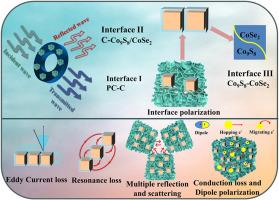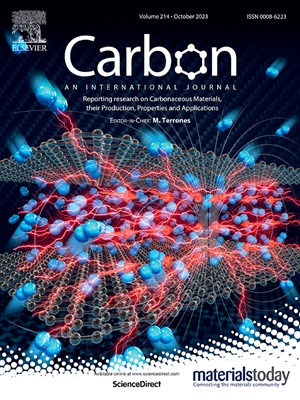Hierarchical core-shell transitional metal chalcogenides Co9S8/ CoSe2@C nanocube embedded into porous carbon for tunable and efficient microwave absorption
IF 11.6
2区 材料科学
Q1 CHEMISTRY, PHYSICAL
引用次数: 0
Abstract
In the domain of electromagnetic (EM) wave absorbing materials, the selection of suitable components and microstructures is an effective approach for designing the intense coupling of wave impedance and EM dissipation. In this study, we have successfully fabricated a double-carbon modified Co9S8/CoSe2 nanocube, where the core-shell Co9S8/CoSe2@C cube was anchored onto porous carbon (PC). The existence of three-dimensional (3D) porous carbon and the fabrication of Co9S8/CoSe2@C distributed on carbon nanosheets contribute to the improvement of conduction, magnetic losses, and the optimization of impedance matching. Substantial heterogeneous interfaces are generated between Co9S8, CoSe2, carbon shells, and PC, leading to extensive interfacial polarization and facilitating the transformation of EM energy into thermal energy. The abundant defects, S and Se vacancies in carbon component can act as polarization centers, inducing dipolar polarization and thus increasing the electromagnetic wave (EMW) loss. The Co9S8/CoSe2@C@PC exhibits the best microwave absorption properties, with a minimum reflection loss (RLmin) of −64.1 dB at 2.5 mm and an effective absorption bandwidth (EAB) of 6.3 GHz. The High-Frequency Structure Simulator results indicate the RCS values of the samples within the range of −90 °C < θ < 90 °C are lower than −20 dB m2, which can achieve almost full-angle coverage in the actual environment. This research offers inspiration and strategies for the design and synthesis of multi-component magneto-electric composites based on transitional metal chalcogenides.

嵌入多孔碳中的分层核壳过渡金属卤化物 Co9S8/ CoSe2@C 纳米管用于可调高效微波吸收
在电磁波吸收材料领域,选择合适的成分和微结构是设计波阻抗和电磁耗散强耦合的有效方法。在这项研究中,我们成功制备了一种双碳改性 Co9S8/CoSe2 纳米立方体,将核壳 Co9S8/CoSe2@C 立方体锚定在多孔碳(PC)上。三维(3D)多孔碳的存在和分布在碳纳米片上的 Co9S8/CoSe2@C 的制造有助于改善传导、磁损耗和阻抗匹配的优化。Co9S8、CoSe2、碳壳和 PC 之间产生了大量的异质界面,导致了广泛的界面极化,促进了电磁能向热能的转化。碳成分中丰富的缺陷、S 和 Se 空位可充当极化中心,诱发双极化,从而增加电磁波(EMW)损耗。Co9S8/CoSe2@C@PC 具有最佳的微波吸收特性,在 2.5 毫米处的最小反射损耗(RLmin)为 -64.1 dB,有效吸收带宽(EAB)为 6.3 GHz。高频结构模拟器结果表明,样品在 -90 °C < θ < 90 °C 范围内的 RCS 值低于 -20 dB m2,在实际环境中几乎可以实现全角度覆盖。这项研究为设计和合成基于过渡金属瑀的多组分磁电复合材料提供了灵感和策略。
本文章由计算机程序翻译,如有差异,请以英文原文为准。
求助全文
约1分钟内获得全文
求助全文
来源期刊

Carbon
工程技术-材料科学:综合
CiteScore
20.80
自引率
7.30%
发文量
0
审稿时长
23 days
期刊介绍:
The journal Carbon is an international multidisciplinary forum for communicating scientific advances in the field of carbon materials. It reports new findings related to the formation, structure, properties, behaviors, and technological applications of carbons. Carbons are a broad class of ordered or disordered solid phases composed primarily of elemental carbon, including but not limited to carbon black, carbon fibers and filaments, carbon nanotubes, diamond and diamond-like carbon, fullerenes, glassy carbon, graphite, graphene, graphene-oxide, porous carbons, pyrolytic carbon, and other sp2 and non-sp2 hybridized carbon systems. Carbon is the companion title to the open access journal Carbon Trends. Relevant application areas for carbon materials include biology and medicine, catalysis, electronic, optoelectronic, spintronic, high-frequency, and photonic devices, energy storage and conversion systems, environmental applications and water treatment, smart materials and systems, and structural and thermal applications.
 求助内容:
求助内容: 应助结果提醒方式:
应助结果提醒方式:


